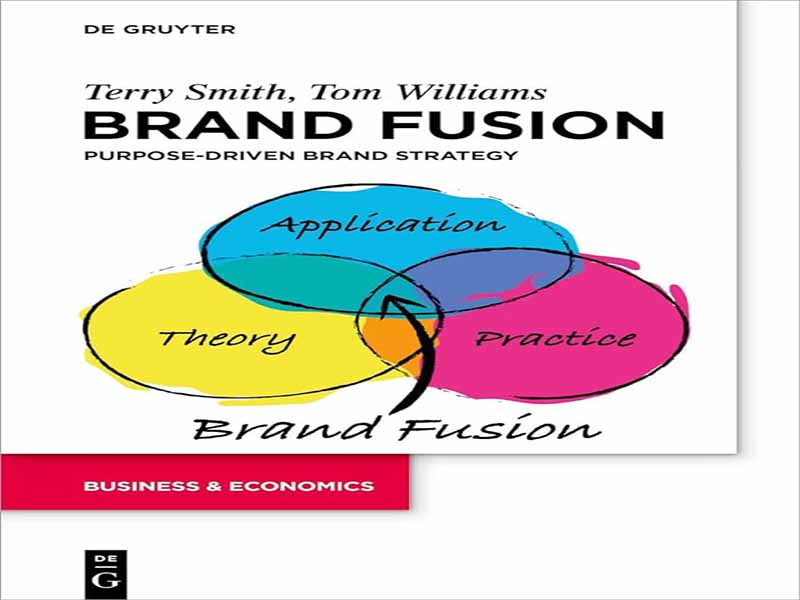- عنوان کتاب: Brand Fusion / Purpose driven brand strategy
- نویسنده: Terry-Smith
- حوزه: بازاریابی
- سال انتشار: 2022
- تعداد صفحه: 622
- زبان اصلی: انگلیسی
- نوع فایل: pdf
- حجم فایل: 8.31 مگابایت
استراتژی برند که هدف محور است – مشتری-شرکت، متقابل ذینفع-سازمان که از اهداف صرفاً سود فراتر می رود- توسط شرکت هایی مانند CMI، CIM، دانشکده بازرگانی هاروارد، Deloitte، Forbes، Regenerate Trust، Mars Catalyst، B حمایت می شود. Corps، دانشگاه آکسفورد، مدرسه بازرگانی ساید، و همچنین استاد اثربخشی پیتر فیلد، از فهرستی که به سرعت در حال گسترش است، فقط چند مورد را نام می برد، و در تحقیقات آکادمیک در حال جلب توجه است، و مهمتر از همه، به طور فزاینده ای در حال اجرا شدن است. توسط برخی از موفق ترین و تاثیرگذارترین شرکت های جهان. مایر (2018) این تمرکز جدید را به خوبی خلاصه میکند و ادعا میکند که هدف شرکتهای امروزی «تولید راهحلهای سودآور برای مشکلات مردم و سیارهها و نه سود بردن از تولید مشکلات برای مردم یا سیارهها» است. این کتاب سند و گواهی بر تئوری، عمل و کاربرد استراتژی برند مبتنی بر هدف است. به عنوان نویسندگان، نقش ما در ایدهپردازی، تحقیق و نگارش این کتاب هم بهعنوان متصدی و هم خالق بوده است: جمعآوری و بررسی طیف گستردهای از تئوری و عمل که زیربنای نظم و پویایی مدیریت استراتژیک برند است. و همچنین به شما ایده های فلسفی و عملی هیجان انگیزی در مورد معنا، مکانیک و جادوی استراتژی برند مبتنی بر هدف در زمینه های سازمانی و اجتماعی گسترده تر آن ارائه می دهد. واضح است که یک استراتژی برند «یک اندازه مناسب» وجود ندارد: این استراتژی باید منحصر به فرد باشد و با محیط های کلان و خرد آن مطابقت داشته باشد. با این حال، یک لنگر ثابت از همه سازمانهایی که با آنها کار کردهایم، برای آنها مشورت کردهایم یا تجزیه و تحلیل کردهایم، این است که برای هدفمند بودن استراتژی برند، باید معنای آن ترسیم، ارزیابی و اصلاح شود. ادغام برند، به عنوان یک پیشنهاد اصلی مدیریت استراتژیک برند، یک محرک اصلی برای توسعه و اجرای استراتژی سازمانی است که مشتری و ذینفعان کلیدی در مرکز ذهنیت برند قرار دارند. این یک انشعاب نیست. نباید اصطکاک، فقط همجوشی وجود داشته باشد. این سنتز تئوری و عمل است. مانند تمام نوآوری ها و تغییر الگوها، تمجید از فضایل هدف برند خالی از انتقاد نیست. برای برخی از شرکتها که غریزه بقا ناشی از اختلال پس از کووید-19 است، نگاه کردن به بلندمدت ممکن است غیر واقعی یا حتی نامناسب به نظر برسد. برای دیگران، ارتباطات با هدف طرح “هدف” ممکن است فورا موثر نباشد. بایرون شارپ، مدیر موسسه Ehrenberg-Bass، که در جشنواره بازاریابی سال گذشته سخنرانی میکرد، استدلال میکند که تمایز از طریق هدف میتواند در نهایت منجر به عدم تمایز شود. تاکتیکهای کوتاهمدت را میتوان اثبات کرد، اما ارزیابی اثرات بلندمدت ممکن است دشوارتر باشد. ممکن است اهداف فقط مشتریان موجود نباشند، بلکه آنهایی که در حاشیه دستهها قرار دارند، باشند. هدف اغلب تعادل بین ایده و ایده آل است. با این حال، این کتاب کاملاً مملو از نمونههایی از سازمانها و برندهای موفق است که هدف آنها نه صرفاً یک ابزار موقت، بلکه بخشی دائمی از استراتژی است. به گفته کان، «هدف واقعی برابر با اقدامات متفکرانه، واقعی و پایدار است که بر کسب و کار در داخل و خارج تأثیر می گذارد، در حالی که تأثیر مثبتی بر جامعه دارد. و سازمانهایی که معتبرترین هدف را دارند، آن را در فرهنگ خود وارد کردهاند، توسط مدیران عاملی که نقش رهبری آنها را درک میکنند، دستور داده شده و الگوبرداری شدهاند». به خوبی اجرا میشوند و «تعهد یک برند تجاری یا شرکت مادر آن به اهدافی غیر از سود یا محصولات بهبود یافته، شامل مشارکت در یک یا چند تأثیر اجتماعی مثبت» دارند. مانند پایداری محیطی، برابری، و فراگیر بودن، همچنین میتوانند تأثیرات مثبتی را در تمایز از رقابت و تقویت روابط مشتری و شرکت ایجاد کنند. موفقیت در اجراست برندهای پایدار، سازمانی که خود را به عنوان «جامعه جهانی از رهبران برند که از چالشهای محیطی و اجتماعی برای هدایت نوآوری، کسبوکار و ارزش استفاده میکنند» توصیف میکند، ادعا میکند که برندها بهطور منحصربهفردی «برای همسو کردن تجارت و جامعه در مسیر یک آینده شکوفا . . و اقتصاد بعدی را کشف کنید.
Brand strategy which is purpose-driven – customer-company, stakeholder-organisation mutuality which transcends profit-only goals – is espoused by the likes of the CMI, CIM, Harvard Business School, Deloitte, Forbes, the Regenerate Trust, Mars Catalyst, B Corps, Oxford University, Säid Business School, as well as the guru of effectiveness Peter Field, to name but a few from a rapidly expanding list, and is gaining some traction in academic research, and, most importantly, is increasingly being put into practice by some of the world’s most successful and influential companies. Mayer (2018) sums this new focus up well, claiming that the aim of today’s companies is “To produce profitable solutions to the problems of people and planet, and not to profit from producing problems for people or planet”. This book is a document of, and testament to, the theory, practice, and application of purpose-driven brand strategy. As authors, our role in conceiving, researching, and writing this book has been both as curators and creators: collecting and examining a wide range of theory and practice which underpins the discipline and dynamics of strategic brand management; as well as presenting to you some exciting philosophical and practical ideas on the meaning, mechanics and magic of purposedriven brand strategy in its broader organisational and societal contexts. It is apparent that there isn’t a ‘one-size-fits-all’ brand strategy: it should be unique and contextualised to itsmacro and micro environments. However, one consistent anchor of all the organisations we have worked with, consulted for, or analysed, is that for brand strategy to be purposeful, then its meaning must be mapped out, evaluated, and refined. Brand Fusion, as a core strategic brand management proposition, is a central driver to organisational strategy development and execution, with the customer and key stakeholder held at the centre of the brand’s mind-set. It is not a bifurcation; there should not be friction, only fusion. It is the synthesis of theory and practice. Like all innovations and paradigm shifts, extolling the virtues of brand purpose is not without criticism. For some companies, distracted by the survival instinct instilled by post-COVID-19 disruption, looking to the long-term may seem unrealistic or even inappropriate. For others, communications aimed at projecting ‘purpose’ may not be immediately effective. Byron Sharp, Director at the Ehrenberg-Bass Institute, speaking at last year’s Festival of Marketing,2 argues that differentiation through purpose could eventually lead to lack of differentiation. Short-term tactics can be proven, but long-term impacts may be more difficult to evaluate. Targets may not just be existing customers but those on the periphery of categories. Purpose is often the balance between idea and ideal. Yet this textbook is absolutely crammed with examples of successful organisations and brands which have purpose as not merely a temporary tool but a permanent part of strategy. According to Cone, “Authentic purpose equals thoughtful, real, and sustained actions that impact the business internally and externally, while having a positive impact on society. And the organisations with the most authentic purpose have it baked into their cultures, mandated and modelled by CEOs who understand their leadership role”.3 Effectiveness expert Peter Field, a stalwart of purpose-driven brand strategy, points to research showing that when purpose campaigns are well-executed and have a “commitment by a commercial brand or its parent company to goals other than improved profits or products, involving contribution towards one or more positive social impacts”4 meeting growing pressure from government, investors, and regulators on ESG matters such as environmental sustainability, equality, and inclusivity, can also deliver positive effects on differentiating from the competitive and enhancing customer-company relationships. Success is in the execution. Sustainable Brands, an organisation who describe themselves as “a global community of brand leaders who are tapping into environmental and social challenges to drive innovation, business, and value” claim that brands are uniquely positioned “to align business and society on the path to a flourishing future . . . and discover the next economy.
این کتاب را میتوانید از لینک زیر بصورت رایگان دانلود کنید:




































نظرات کاربران